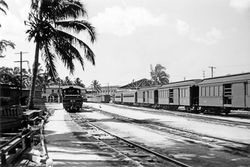Oahu Railway & Land Company
Hawaii / Common Carrier / Oahu Railway & Land Company
History
by Jeff Livingston.
Benjamin Franklin Dillingham, a Massachusetts sailor turned businessman, obtained a Charter from Hawaiian King David Kalakaua to build a railroad from Honolulu to the Pearl River in 1888. Ground breaking for the “Terminal Division”, and “Pearl River Division” of the Oahu Railway and Land Company (OR&L) was in March 1889. The railroad was rapidly built the 12 miles from Honolulu to the Pearl River Lagoon (Pearl Harbor). There was no industry and insufficient agriculture along the new railroad to support it by freight. Dillingham intended his revenue to come from passenger service and to ensure passengers would be available he developed housing lots on what is now the Pearl City Peninsula to generate passenger and light freight traffic.
The main line was extended to the Ewa Plantation, a new sugar plantation on the Ewa Plain, 18 miles from Honolulu by 1892. Further progress was delayed due to the overthrow of the Hawaiian Monarchy and establishment of the Republic. Construction resumed in 1894 from Ewa to Waianae, 33 miles from Honolulu, with regular trains operating from July 1, 1895. The main line was pushed further around the island reaching Waialua, 56 miles from Honolulu in June 1898 and finally Kahuku, 71 miles from Honolulu opening for service January 1, 1899. The OR&L now connected five sugar plantations by rail to Honolulu and no longer relied on passenger traffic for its sole source of revenue. Although the OR&L had surveyed an extension of the main line from Kahuku to Waimanalo, another 20 plus miles along the coast, this extension was never built and Kahuku became the “end of the line”. The OR&L continued to grow adding additional locomotives, freight and passenger cars in the ensuing years. The last significant track construction was a branch line from Waipahu to Wahiawa, about 11 miles, to reach the pineapple fields. The Wahiawa Branch was completed in 1906.
The OR&L maintained a close relationship with the military establishment and as additional branches were constructed off the Wahiawa Branch they included service to the U.S. Army at Schofield Barracks. Construction at Pearl Harbor of the U.S. Navy’s battleship drydock and shipyard beginning in 1908 provided the OR&L with another significant source of revenue. The OR&L continued to evolve between 1910 and 1940. The last new steam locomotives purchased were four 2-8-2 American Locomotive works Mikado’s, virtually identical to the much better known Denver and Rio Grande Western K-28’s, in 1925 and 1926.
With the outbreak of the Second World War both the OR&L’s equipment and that of the military were severely taxed. Used narrow gauge equipment was sent to the Army and Navy to help fill the equipment gaps and the OR&L purchased what they could from the mainland. Running a 24 hour 7 day a week schedule the OR&L secured two General Electric 47-ton diesel electric locomotives in 1943. These locomotives were sent to the OR&L before either the Army or the Navy received any new locomotives illustrating the importance of the OR&L to the war effort.
At the conclusion of the war the OR&L’s equipment was functional but in disrepair. The OR&L prepared a tariff increase to allow for the purchase of new equipment and contacted their customers to alert them to the forth coming rate increases. Virtually all refused to consider these rate increases preferring to shift to trucking over the improved road system built by the military during the war. As a consequence, the OR&L applied to the Interstate Commerce Commission to abandon their main line. Abandonment was approved and the OR&L made its last regular run on December 31, 1947 becoming a terminal railroad under the name of Oahu Railway (OR) serving the piers, pineapple canneries and slaughter house in Honolulu. Four steam locomotives were sold along with 280 boxcars to South American railroads. A few freight cars were sold to local plantations, fewer items were donated to interested groups and the bulk of the remaining equipment scrapped with the exception of the two diesels and one 0-6-0 steam switch engine.
In 1959 the OR rebuilt their yard in Honolulu as a container yard and began handling containers to and from Matson ships docking at four piers in Honolulu. These piers were already equipped with OR tracks. This new system was installed at considerable expense to the OR and included the purchase of a large number of surplus U.S. Navy flat cars and boxcars and a new Plymouth 35-ton diesel mechanical locomotive. Shortly after completion of the container yard the new State of Hawaii government built a huge container yard and ship berths at Sand Island well beyond the reach of the OR’s tracks. The OR dismantled the container yard and continued hauling pineapple from the piers until the end of the 1971 season. The Oahu Railway, (Oahu Railway and Land Company), ceased all railroad operations on December 31, 1971.
Bibliography
Hilton, George W. (1990). American Narrow Gauge Railroads. Stanford: Stanford University Press. ISBN 0-8047-2369-9.
OR&L corporate records held at the Bernice Pauahi Bishop Museum.
OR&L company officials, interviews by Bob Paoa HRS Historian Emeritus.



